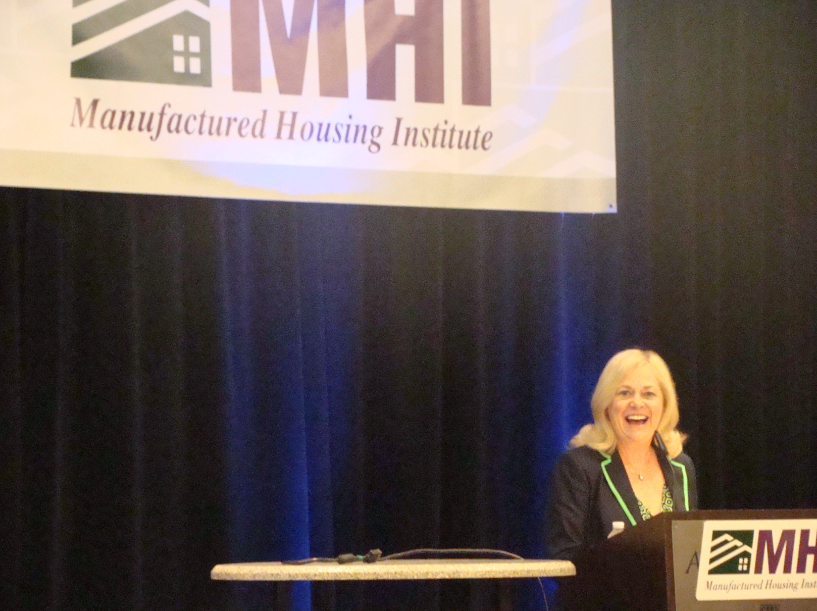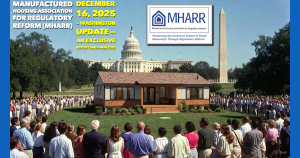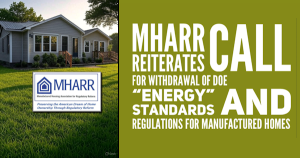[vc_row][vc_column][vc_column_text]The Italian philosopher, Niccolo Machiavelli, famously wrote in his political masterpiece, “The Prince” that “he who studies what ought to be done rather than what is done, will learn the way to his downfall rather  than to his preservation.” And, it would appear, this is exactly what Pamela Danner — the Obama Administration holdover currently running the federal manufactured housing program – is counting on.
than to his preservation.” And, it would appear, this is exactly what Pamela Danner — the Obama Administration holdover currently running the federal manufactured housing program – is counting on.
While a steady gusher of “fake news,” “happy-faced” public relations (PR) pieces, distractions and other diversions is peddled by the Administrator, the program (as MHARR has painstakingly documented) continues to veer far off track, with manufacturers, consumers, and even state regulators being subjected to ever-more intrusive, debilitating, costly and manifestly unnecessary regulatory mandates — all despite the arrival of Dr. Benjamin Carson as HUD Secretary. And for every day this continues, without the appointment of a new program administrator who actually embraces – rather than defies and resists – the broad regulatory relief agenda of the Trump Administration, the industry not only loses important ground, but faces a growing threat that it will be left behind entirely while other regulated industries grow and prosper as a result of that agenda.
The fundamentally misleading narrative being advanced by the program leadership in order to pacify part of the industry and provide “cover” for others who, for their own reasons, would prefer to see the status quo maintained (and the current program administrator protected amidst an otherwise precarious new environment under the Trump Administration), involves three related “public relations” elements.
The first of these was on full display just a few short weeks ago, as the HUD program, to great fanfare — as touted by the Manufactured Housing Institute (MHI) in its April 19, 2017 “News and Updates” publication and some state association newsletters — conducted a so-called “digital campaign” over HUD’s computer intranet, to “help raise awareness of how the manufactured housing industry impacts homeownership and employment nationwide.”
With this “digital campaign,” the program and the program administrator, after ignoring the specific directives of the 2000 reform law to promote the acceptance of HUD-regulated manufactured housing, both within and outside of HUD — for 17 years and nearly four years respectively – threw the industry a virtually meaningless “bone.” Forget any effort to advance the really hard – and potentially controversial — work of achieving what these mandates were actually designed to do: i.e., (1) help overcome rampant discrimination against (and the discriminatory exclusion of) HUD Code homes and HUD Code communities by local governments; and (2) help integrate manufactured housing as a key element of all HUD policymaking and all HUD housing programs. No, that would require leadership and initiative. So instead, after years of doing absolutely nothing to advance the acceptance and utilization of manufactured housing – either within HUD or otherwise – to the point that HUD-regulated manufactured housing was not even mentioned as an affordable housing resource in the last two “strategic plans” developed by the Department itself, and after public calls by MHARR for the administrator to be re-assigned and replaced, the program has finally gotten around to making a minimal, symbolic show of supposedly fulfilling one element of the 2000 reform law. Why? So that the administrator (and her active or tacit supporters) can point to a purported “accomplishment” in a bid to stay right where she is. And, indeed, this very “campaign” was regurgitated in a recent HUD communication to MHARR as representing action by the administrator “to raise the profile, understanding and importance of manufactured housing internally at HUD.” What a surprise.
The second element of this public relations triad is the manufactured housing program’s periodic newsletter, ironically named “The FACTs.” For a program that claims to be chronically underfunded, that has failed to adjust (i.e., increase) payments to its “state partners” for 15 years, and has been engaged in a thinly-disguised campaign to starve State Administrative Agencies (SAA) of the cash they need to fulfill continually increasing but baseless mandates, HUD somehow finds the resources to publish a multi-page quarterly newsletter touting the views and perspective of the program and the program administrator.
In one small (yet very significant) example of the misdirection and deception that pervades this publication, the most recent edition of “The FACTs” (June 2017) stated, in part: “The HUD-Administered Manufactured Home Installation Program has experienced great success and growth so far in 2017” as, among other things, it “welcomed the state of Michigan into the program in May.” For anyone familiar with the sorry saga of Michigan’s withdrawal from the federal program, however — facing increased responsibilities combined with severe revenue shortfalls — it is doubtful that the word “success” would spring to mind. Nor is the withdrawal of a top-ten shipment state from participation in a program designed by Congress to be a federal-state partnership, leading to increased power and revenues for an unaccountable contractor, something to be “welcomed” by anyone. Indeed, it represents a distinct failure of both the program and the administrator — and could be the harbinger of further state defections from the program that could undermine its fundamental character and legitimacy, if the current administrator remains.
The third element of the administrator’s public relations strategy is personal travel — and presentations to – industry gatherings, including MHI meetings, meetings of various state associations, and SAA/PIA meetings in order to rally support for the program’s “line” of diversion and misinformation without serious challenge or disagreement, while, in the meantime, the program and its revenue-driven contractors continually churn out new regulatory and pseudo-regulatory mandates that ratchet-up regulatory compliance burdens and costs with little or no corresponding benefits for consumers.
In the meantime, while the administrator has appeared at multiple PR meetings since the beginning of 2017, the Manufactured Housing Consensus Committee (MHCC) – the stakeholder body charged by statute with considering and recommending new standards, regulations and interpretations, and, more importantly, acting as the guardian of fair and reasonable federal regulation in full accordance with the law – has not had a single meeting yet in 2017, and no meeting is currently scheduled. Of course, with the push-back that the administrator has been getting from the program stakeholders represented on the MHCC (reflected in the now routine rejection of MHCC recommendations by HUD on major issues, including on-site construction and HUD’s proposed “frost-free” foundation Interpretive Bulletin) it is not surprising that she would seek to avoid more of those meetings.
So behind this wall of distraction and diversion that is all too readily accepted within certain industry circles, what is actually going on within the federal program? Well, the program, under this administrator, has – and is: (1) seeking to implement a federal takeover of installation regulation in all fifty states; (2) seeking to implement extremely costly changes to the existing federal standards for “frost-free” foundations via an alleged “Interpretive Bulletin” (rejecting multiple MHCC recommendations in the process); (3) destroying the HUD Code on-site completion market through its overdone, over-reaching and over-wrought “on-site completion” rule (again rejecting multiple MHCC recommendations in the process); (4) is in the process of driving states out of the program through a combination of increased duties and unchanged funding levels (as contrasted with increased funding for the program monitoring contractor); (5) is increasing the role, power and authority of unaccountable program contractors via “make-work” functions that needlessly increase costs; (6) has needlessly expanded regulatory burdens and compliance costs with its mandatory “at least monthly” review of manufacturer service records; (7) is beating the bushes for more federal dispute resolution referrals, while denying that current minimal referral levels reflect positively on the quality of manufactured homes or manufacturers’ customer service; and (8) has failed to take action to implement an MHCC recommendation to permit multi-family manufactured housing, and thereby open an entirely new HUD Code market – among other things.
It is fair to ask, then – and indeed, must be asked in order to place all of this in proper perspective – exactly who benefits from the harsh (and worsening) reality being hidden behind the wall of distraction? Part of the industry that helps in trafficking the distractions undoubtedly would prefer that you not know the underlying reality and who actually benefits. MHARR, however, has been studying and analyzing the available facts, and has drawn conclusions that will be addressed in an upcoming “Issues and Perspectives” column.
To summarize for now, President Trump has been in office for nearly seven months. His regulatory policies and regulatory reform agenda could and would help the industry, which continues to experience slow growth, with new markets choked-off or seriously impaired by federal regulation (e.g., on-site and multi-family), while existing markets are similarly being burdened with new, expanded and/or intensified regulation that is totally unnecessary (e.g., “frost-free” foundation mandates). The industry and its consumers, therefore, continue to suffer, because the Trump Administration’s reform agenda is effectively blocked within the federal program by the current Obama-holdover administrator.
Sadly, this is a self-inflicted wound, as part of the industry has failed to join MHARR in publicly calling for — and aggressively seeking — the current administrator’s re-assignment and replacement by a qualified nominee with industry experience, even though the path to annual industry production levels in the hundreds-of-thousands of homes is in clear sight. This leadership change should have been demanded and accomplished right away. Now, though, with valuable time wasted and being wasted with each new day, the industry needs to awaken to the reality that exists and demand change before its window of opportunity closes completely.
Mark Weiss
MHARR is a Washington, D.C.-based national trade association representing the views and interests of independent producers of federally-regulated manufactured housing.
“MHARR-Issues and Perspectives” is available for re-publication in full (i.e., without alteration or substantive modification) without further permission and with proper attribution to MHARR. [/vc_column_text][/vc_column][/vc_row][vc_row][vc_column][/vc_column][/vc_row]













